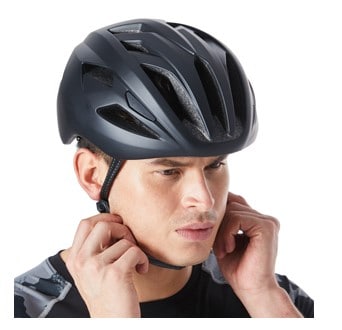One of the most vital parts of cycling gear is the helmet. In case of a crash, a helmet may save your life, and therefore, you need to ensure it stays in its peak condition. In that case, how often should you replace your bike helmet?
It is advisable to replace your bike helmet after 5-10 years, depending on the frequency of use and the kind of care you accord it. Also, if you had a crash, you need to replace your helmet. In addition, when your cycling helmet starts showing signs of degradation, it’s time to get a new one.
All the same, modern-day helmets can outlast the recommended time. However, if the helmet doesn’t fit well or comes from the ’70s and early ’80s, you need to replace them.
How Long Does A Cycling Helmet Last?
The lifespan of a biking helmet depends mostly on how well you take care of it. All the same, even with the best care, this piece of equipment will need regular checking for any defects.
According to most manufacturers, a good helmet should last between 5 and 10 years, depending on how much you use it.
On the contrary, MEA Forensic reported in 2015 that their testing on used helmets (without crash history) showed that the foam liners retain their efficiency for many years.
Actually, some helmets were 26 years old, and their performance was uncompromised.
From these reports, it is clear that bike helmets can outlast their life expectancy. All the same, it is always prudent to adhere to manufacturers’ advice. Actually, you need to regularly (3-4 months) check your helmet for any faults.
Specifically, check for cracks and dents on the shell. Also, if the outside looks faded or the shell separates from the EPS, it is time to replace your bike helmet.
How Often Should You Replace Your Bike Helmet?
Unfortunately, some cyclists are most times reluctant to replace their bike helmets. Although the majority of the modern-day helmets hold to their integrity long beyond their expected lifetime, there are some conditions that will call for immediate replacement of your bike helmet. Some of them include:
1. Replace Your Bike Helmet After A Crash
One of the most crucial times you need to replace your helmet is after a crash, especially when the head was hit.
Notably, the helmet’s foam is designed to protect you from one crash. After that one-time crash, the helmet is toast, and it can’t protect you in subsequent incidences.
It would be suicidal to continue using a cycling helmet whose integrity is compromised.
Replacing a bike helmet after a crash should not be debatable. It would be best if you got a new helmet for your next ride.
Therefore, a good helmet such as the Schwinn Thrasher Bike Helmet,(Link to Amazon) which is pocket-friendly, will help you stay secure. Notably, the brand has sizes for all children, youths, and adults.

2. After A Hard Drop
If your helmet falls on a hard surface, it may crack, thereby warranting a replacement. Actually, on dropping the helmet, it forms some small cracks that are easy to overlook. All the same, those faults are life-threatening.
Although the helmet looks perfect even after falling, please take it to the manufacturers for inspection before using it. Notably, most manufacturers examine crashed helmets if they need replacement and replace them for a small fee.
3. When It Fits Badly
The other factor that should make you replace your current bike helmet is how it fits. If the headgear is too tight or too loose, then it may not protect you as expected in case of a crash.
Therefore, a good helmet should comfortably fit your head, which would help avoid unnecessary injuries.
Mostly, modern bike helmets such as the BASE CAMP Road Bike Helmet have a full fitting system that enfolds the head.
They also cradle to the rear of the head and snug against your forehead, making sure the helmet stays firmly in place.
4. When There Are Visible Signs Of Damage
After several years, your bike helmet will definitely start degrading. Therefore, regular inspection of helmets for possible damages is a prudent thing to do.
So, what signs will you be specifically looking for to stay safe?
Like other plastic materials, bike helmets degrade over time. All the same, the rate of degradation is so small that you may fail to notice.
First, if the shell starts showing dents of any kind, you need to dispose of it.
In addition, check the vents for any cracks or splitting of the EPS. Also, if one part, such as the straps, is missing, you need to consider getting a new outfit.
Most importantly, when the polycarbonate shell starts to separate from the EPS, don’t take a second guess; go for a new helmet.
5. It Is From The ’70s And ’80s
On the other hand, if your bike helmet is one of those antique collections from the ’70s and ’80s, you definitely need to upgrade.
Although most of these old helmets look appealing, they don’t meet modern-day safety standards. In that case, they cannot the badly needed protection in a severe crash.
Notably, some of these helmets don’t have a hard shell, which puts you in danger even in a minor accident.
In addition, helmets from the ’70s may have a hard shell but have thin Styrofoam liners. This, too, puts you in danger in the event of an accident.
All the same, if your bike from the ’80s has a Snell or ASTM sticker, you may not need to replace it. Just take it for inspection, and the manufacturer will advise you accordingly.
However, if you decide to go for a new cycling helmet, it would be a perfect choice.

How To Care For Your Bike Helmet
Every bike helmet comes with a user’s manual that indicates the product’s life expectancy. First, it indicates that you should replace the equipment in case of a crash or after a certain number of years.
All the same, here are a few factors that help you extend the life of your helmet.
Avoid Chemical Exposure
Notably, chemicals can compromise the quality of EPS if they come into contact. When we mention chemicals, you may be thinking of the toxic chemicals that have scorching effects.
Well, they could also damage your helmet, but we are talking about common products such as lubricants and degreasers. They, too, can degrade EPS.
Actually, helmet manufacturers recommend that you clean your helmet with soapy water and note any other chemical form.
Protect The Helmet From Knocks
It would help if you practiced general safety and protection for your helmet to last long. You need to ensure that the helmet doesn’t suffer any knocks or bumps unless it is in an accident.
Therefore, when you transport or store the helmet, ensure that it is in a safe place. Notably, it is easy to forget the helmet when it’s not in use, but you must ensure its quality doesn’t get compromised by poor handling.
Other Frequently Asked Questions
1. How Much Does A Good Helmet Cost?
A good bike helmet will cost anywhere between $100 to $ 1000, depending on your budget and the features you find necessary.
All the same, some helmets cost less than $40, but they may not meet some crucial specifications.
2. How Much Should You Spend On A Bike Helmet?
A decent bike helmet that is DoT approved should cost you about $150-$250 on average. Notably, high-end cycling helmets may cost well over $1000, while the lowest end of the market has products that go for as little as $40.
Therefore, you don’t have to break a bank to get a credible bike helmet.
3. Do Helmets Really Expire?
The EPS foam used to make helmet liners do not degrade with time. However, the shell, just like any other plastic item, will eventually lose its integrity.
Despite manufacturers adding UV inhibitors to the shell plastic, it still gets affected by exposure to direct sunlight, although at a lower rate.
If your helmet looks faded, it is a sign that the time for replacing it is at hand.
Actually, that’s why most manufacturers recommend getting a new helmet every 5 to 10 years. You can find more information on “Do Bike Helmets Expire” from this post that we had earlier written.
4. Can You Use A Bike Helmet After A Crash?
After any crash, you should not use that specific bike helmet again, but instead, get a new one. Although it may seem to be in perfect shape, the helmet will most likely have developed weaknesses that will make it unhelpful on a second tumble.
5. What Do You Do With Old Bike Helmets?
For damaged helmets, you can put them up for recycling. Since most recycling plants don’t mix materials, the best thing to do with your old helmet is to take it apart. As such, you will put plastic in the plastic recycle bin.
Final Word on ”how often should you replace your bike helmet”.
Most manufacturers recommend getting a new helmet every 5-10 years. Most importantly, the rule of the thumb is that you should dispose of your helmet following a crash.
Also, if the helmet falls heavily on a hard surface, you should replace it. In addition, if the shell starts showing any signs of degradation, don’t wait till you crash to replace it. Do it right away.
Finally, to keep the environment clean, it is advisable to put damaged helmets in the recycle bin.
Also Read: Are bicycle helmets worth it?
Frequently Asked Questions
How long does a bicycle helmet last?
Well, most companies that manufacture helmets, including renowned brands, recommend changing your helmet every five years. However, this may be a marketing strategy to some extent because Bell, for instance, suggests every three years which appears a too brief span. Their reason is somewhat based on updating your helmet technology, but I suggest taking this piece of advice conservatively.
It is crucial to remember that my years of cycling experience have taught me that the longevity of helmets primarily depends on how much you use them and how well you care for them. Regardless, the typical “five years rule” can be handy if you’re uncertain about your helmet’s health.
Do I really need to replace my helmet after 5 years?
Yes, it is generally wise to replace your helmet every 5 years or 7 years from the production date. You may wonder why this is so. The reason is that the material from which the helmet is made, including resin, can degrade over time. Factors that accelerate this deterioration include your body fluids, oils from your hair, the effects of sunlight (ultraviolet light), and the usual wear and tear.
The helmet is meant to provide you safety, and any compromise on its structural integrity can risk its effectiveness. Based on my experience, I feel it is a small price to pay for safety. Therefore, consider it as a worthy investment for your safety rather than a mere expense.
How do I know if my bike helmet is bad?
Determining whether your bike helmet is no longer safe to use requires some attention. The first step is to inspect it under proper light. Carefully observe both the interior and exterior of your helmet. Look for any signs of crushing or cracking. If you discover only minor crushing, the helmet might still be safe to use. As per what Parks suggests, another accident is less likely to impact the same spot.
From my own experiences, I also recommend checking the straps and adjusting system. If they’re worn out or are not adjusting well, it’s time to get a new helmet. You should never compromise on safety. Therefore, regular inspection of your helmet is an excellent practice to ensure your bicycle rides are always safe.